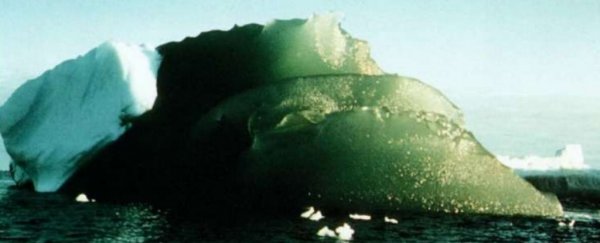Some icebergs look white. Others look blue. But perhaps the most precious of all appear emerald green.
Ever since the 1900s, sailors and explorers have occasionally seen these strange green icebergs, or jade bergs, floating around in the grey Antarctic landscape.
Their curious colour has been puzzling scientists for decades; now, we might finally have a plausible explanation of this phenomenon.
In a new paper, a team of glaciologists propose these icebergs are turning green because they contain iron oxides carried from Antarctica's mainland.
If the hunch is correct, it means that jade burgs are essentially like frozen waiters, serving a crucial nutrient that supports nearly all marine life.
"It's like taking a package to the post office. The iceberg can deliver this iron out into the ocean far away, and then melt and deliver it to the phytoplankton that can use it as a nutrient," says the paper's lead author, glaciologist Stephen Warren from the University of Washington.
"We always thought green icebergs were just an exotic curiosity, but now we think they may actually be important."
Warren started studying this phenomenon way back in 1988, and at first, he was struck less by the colour of these slabs of ice, and more by their density. Unlike normal icebergs, which are built from packed down snow, these green ones seemed to be void of any air pockets.
"This ice had no bubbles," explains Warren. "It was obvious that it was not ordinary glacier ice."
Analysing several green icebergs, sampled in the 1980s, Warren and his colleagues quickly realised these frozen structures did not break off a glacier like most icebergs do.
Instead, it looked like they were formed by marine ice, the frozen ocean water that clings to the underside of an Antarctic ice shelf.
Hence, their first thought was that the green colour came from dissolved marine plants and animals, perished long ago and still floating in the water. This organic matter would be yellow in colour, and if it somehow got trapped in the blue ice, it could possibly turn the whole thing green.
But when the researchers measured for organic matter, they found little difference between green ice and blue ice. Something else must be at play, but what?
The question nagged Warren for decades; a few years ago, he finally got a big lead. In 2016, a team of oceanographers led by Laura Herraiz-Borreguero from the University of Copenhagen tested an ice core taken from the Amery Ice Shelf back in 1968. At the very bottom, they found marine ice with nearly 500 times more iron than the glacial ice above.
Iron oxides tend to have a rusty, earthy hue to them, and they are found in rocks from Antarctica's mainland. In fact, as glaciers flow over bedrock, they often grind these rocks to a fine powder which can then make its way into the sea.
Warren and colleagues now think that this iron oxide dust is getting trapped under the ice shelf and incorporated into the marine ice. They hypothesise this is what's causing the stunning emerald colours, and propose a series of tests on short cores of icebergs to "confirm or dispute that hypothesis," according to their paper.
Iron is a key nutrient for the animals that make up the base of the marine food web, like phytoplankton and microscopic plants.
Nevertheless, this crucial nutrient is scarce in many parts of the ocean, and jade bergs may be one of the only sources. Which makes these jewel-coloured slabs of ice truly precious.
This study has been published in Journal of Geophysical Research: Oceans.
